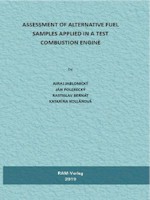Campus Licence Campuslizenz
|
|
 |
Introduction
Environmental and energy issues rank among the major issues in nowadays society. Transportation plays a significant role in formation of hazardous emissions as well as in energy consumption. According to the level of mo-torization the transportation industry participates to air pollution in a range from 13% to 20%. The main part of liquid fuels consumption is in road and railway traffic. Energy consumption in transportation is growing in absolute terms, i.e. in energy units, but also in relative terms, which can be character-ized by its amount in the total energy consumption in all major regions of the world. At present the transportation industry is involved in energy con-sumption in the EU countries by approximately of 32%. Thus, we can say that the transportation industry belongs among the most energy-consuming sectors in the world.
Combustion engines serve as basic propulsion units in mobile vehicles used in transportation. One of the main disadvantages of these engines is the production exhaust emissions. Exhaust emissions of diesel engines have a negative impact both on the environment and humans. These emissions include pollutants, especially „greenhouse“ gases, which cause gradual irreversible warming of the planet and disturb the balance in nature with acid rains. We mean particularly carbon dioxide CO2, nitrogen oxides NOx, methane CH4 and sulfur oxides SOX.
The exhaust gases of diesel engines constitute a complex mixture of compounds present in solid and gaseous phases and contain certain classes of compounds such as polycyclic aromatic hydrocarbons, many of which are genotoxic. These gases are released to the atmosphere by burning fossil fuels (crude oil, coal and natural gas).
The European Union has adopted measures to ensure reduction of greenhouse gases emissions by 20% by 2020 compared to 1990. The
European Community as the regulatory institution for motor vehicles has established limit requirements on vehicles in terms of their impact on the environment. In order to reduce the greenhouse gases emissions, certain measures have been proposed to replace up to 10% of standard hydrocarbon fuels by biofuels by the year 2020.
As mentioned above, the European Community as the regulatory institution for motor vehicles, has established stricter emission standards and, as a result, the transportation industry is undergoing rapid transformation to comply with these standards. In present days many technologies for reduction of particulate emissions are being used. These include engine modifications, emission control devices and use of alternative fuels.
One of the ways how to comply with stricter emission regulations is to fo-cus attention on search of suitable alternative fuels as described in TAU-ZIA, et al. (2010) in the publication „Experimental study of inlet manifold water injection on combustion and emissions of an automotive direct injec-tion diesel engine“. The main alternative fuels that could be used in auto-motive transportation are ethanol, hydrogen and biodiesel. The ethanol technology is already commercially expanded both in developing and de-veloped countries but the use of ethanol is limited only to petrol engines. Fuel cells based on hydrogen could become a real alternative to fossil fuels, but to make them commercially usable, there are many technical problems that have to be solved, e.g.: hydrogen production difficulties, requirements on special infrastructure for its storage and higher production costs. Despite the initial research carried out with hydrogen-powered fuel cells, they are expected to be used in diesel engines designed for locomotives, ships and trucks. A large number of studies have shown that biodiesel could serve as an alternative fuel. This is one of the fuels that could be used in diesel en-gines with little or no modification requirements. It has also been shown that biodiesel has a significant potential to reduce CO2, CO, THC and PM emissions.
We can say that alternative fuels or their blends with diesel fuel are con-stantly being investigated with emphasis on reducing emissions formed by combustion and also on tasks of converting their thermal energy into me-chanical work.

